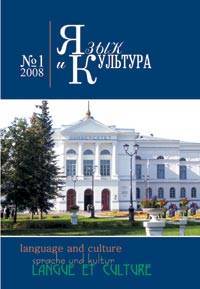Promotion of the Russian language in the Eurasian space through the culture and lifestyle of the peoples of Siberia
This article is well-founded and theoretically grounded in the analysis of global language education, in which an attempt is made to introduce elements of Russian-language discourse with a regional component. Today, it is necessary to expand the methodology and methodological boundaries and take a fresh look at teaching of the Russian language. The introduction of the regional component, consisting of the toponyms, anthroponyms and other strata of the vocabulary of the indigenous peoples of the region, elements of their folklore, traditions, beliefs, will certainly help expand the boundaries of interest in Russian as a foreign language and promote its more successful promotion into the Eurasian space. Each region of the multicultural space of Russia has its own geographical, social and ethnic specifics. Often this specificity is reflected in the names of the region itself, for example, the Khanty-Mansiysk National Okrug, the Yamalo-Nenets Autonomous District, the Chukchi-Koryak National District, the Krasno-Selkup District, and the Republic of Sakha. The name of the Tomsk region has no direct indication of the presence of indigenous peoples, representing the pre-Russian population of Siberia. However, the geographical map of the Tomsk region is full of names of the main ethnic groups of the region: Tom, Basandyika, Ushayka, Takhtamyshe-vo are terms of the Siberian Tatars; Kargasok, Vargananjino, Kolta Kup-Selkup terms; Vasyugan, Yugan, Tukh Emter are Khanty terms. A special attraction to the study of Russian discourse will be the interpretations of these terms and provide a better understanding of the history and culture of the region. Russian texts, compiled based on the folklore of the indigenous population of the region, will introduce foreign students to romantic legends of the beautiful Tom and the hero Ushai; explain the origin of the names of the rivers Basandayka and Vasyugan; tell about the history of the village of Kargasok. The task of modern linguists and teachers to reflect in the training material regional specificity and develop a methodology for the introduction of this material into the educational process. The general paradigm of foreign-language education in Russia is oriented towards intercultural communication, therefore in pedagogical science the idea of achieving tolerance and cultural relativity acquires special relevance
Keywords
Томская область, аборигенные этносы Сибири, культура, фольклор, преподавание русского языка, Tomsk region, aboriginal ethnic groups of Siberia, culture, folklore, teaching of the Russian languageAuthors
| Name | Organization | |
| Gilltspie D. | University of Bath | gural.svetlana@mail.ru |
| Gural S.K. | Tomsk State University | gural.svetlana@mail.ru |
| Kim-Maloney A.A. | Tomsk State Pedagogical University; Tomsk State University | alexandrakim@hotmail.com |
References

Promotion of the Russian language in the Eurasian space through the culture and lifestyle of the peoples of Siberia | Yazyk i Kultura – Language and Culture. 2017. № 40. DOI: 10.17223/19996195/40/1
